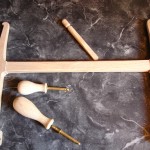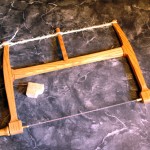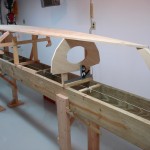A few weeks ago, I cursed a wretched coping saw as I cut the oval hatches in the Fiddlehead’s bulkheads. A week or so later, I needed a turning saw to cut the long gradual curves on the Fiddlehead’s bottom, and actually hacked together a temporary saw from a hacksaw frame and part of a used bandsaw blade. It worked, but it’s a good thing the curved line wasn’t too far from the edge of the board.
 Those incidents led me to make a bow saw. Of the available designs, I found the Gramercy Tools design most appealing. The design is classic, yet uses a moderm pair of brass pins to hold the blade. The pins can accommodate blades that already have pins pressed in, or blades that have open eyelets. The Gramercy bow saw is available from Tools for Working Wood as a completed saw for $139.95, or as individual parts. Gramercy offers a very complete set of drawings for people who want to make their own. I chose to buy only the pins and blades and make all the wooden parts myself. While they use Hickory, I used Oak because that’s what I had on hand.
Those incidents led me to make a bow saw. Of the available designs, I found the Gramercy Tools design most appealing. The design is classic, yet uses a moderm pair of brass pins to hold the blade. The pins can accommodate blades that already have pins pressed in, or blades that have open eyelets. The Gramercy bow saw is available from Tools for Working Wood as a completed saw for $139.95, or as individual parts. Gramercy offers a very complete set of drawings for people who want to make their own. I chose to buy only the pins and blades and make all the wooden parts myself. While they use Hickory, I used Oak because that’s what I had on hand.
 Features that appealed to me are: the classic style, the curved faces of the mortise joints on the stretcher (fun cutting them, allows for slightly varying blade lengths), and the subtle sculpting of the various curves and edges, including a finger rest near the base of the cheeks.
Features that appealed to me are: the classic style, the curved faces of the mortise joints on the stretcher (fun cutting them, allows for slightly varying blade lengths), and the subtle sculpting of the various curves and edges, including a finger rest near the base of the cheeks.
The pins are glued into the handles with epoxy. I used a couple of coats of boiled linseed oil for finish. It still needs a good cord for tensioning. The fuzzy hemp is temporary, enough to try it out. The blade is 12 inches long. This blade is the coarsest of a set of three, 10 tpi.
That little squiggly block of wood represents the first cut, an S shape about an inch long, through 4/4 cedar. The saw ends up being very light and pleasing to use. While I thought the handle a bit small when I was turning it, I find that it falls very naturally into the hand. Gramercy did a fine job on the design. This one is a keeper!
For Luke and Dan: Yes, I used electrons while building this saw. I used a bandsaw to resaw the oak to useful dimensions, and I used an ancient miniature lathe to turn the handle, toe, and toggle. The lathe was only moderately easier than hacking them out with a pocket knife. Oh yes, there are also electric lights in the shop. The remainder of the making used hand tools, rasps and the eggbeater drill.
So now, we’ll have many fewer colorful words while sawing.
Update (12/13): Those brass pins from Gramercy are so smooth that the saw frame wants to rotate around them a little too easily. More tension? The blade already sings a high C when plinked. A small sliver of 320 grit sandpaper inserted along with the pin provides exactly the right friction. For long time coping saw users, this saw is a great upgrade. Break the habit of taking short stokes, Use the entire length of the blade and be amazed at how easily the saw works.
